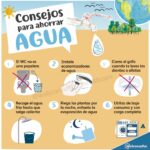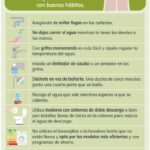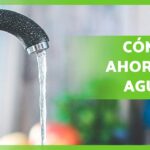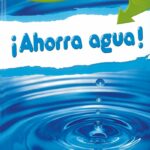
1. Limit your Water Usage
💧 1. Limita tu consumo de agua 💧
En nuestra vida diaria, a menudo damos por sentado el agua que usamos. Sin embargo, es esencial recordar que el agua es un recurso finito y que debemos hacer todo lo posible para conservarla. Limitar nuestro consumo de agua no solo beneficia al medio ambiente, sino que también puede ayudarnos a ahorrar dinero en las facturas del agua. Aquí hay algunas formas simples pero efectivas de reducir nuestro uso de agua en casa.
🚿 Primero, considera la duración de tus duchas. Tomar duchas más cortas puede marcar una gran diferencia en la cantidad de agua que utilizamos. Intenta establecer un límite de tiempo y haz todo lo posible para mantenerlo.
🌳 Además, asegúrate de revisar y reparar cualquier fuga de agua en tu hogar. Incluso las pequeñas fugas pueden sumar grandes cantidades de agua desperdiciada a lo largo del tiempo. Presta atención a los grifos, tuberías y otros accesorios para asegurarte de que no haya fugas.
🌱 Considera también la opción de instalar equipos y electrodomésticos eficientes en cuanto al uso del agua. Los inodoros de bajo flujo, los regadores de jardín con temporizadores y las lavadoras de ropa con certificación WaterSense son solo algunos ejemplos de cómo podemos reducir nuestro consumo de agua sin sacrificar la calidad de vida.
🌊 Finalmente, se consciente de cómo usas el agua en tu hogar. No olvides cerrar el grifo mientras te cepillas los dientes, lavas los platos o te afeitas. También puedes recolectar el agua de lluvia para regar las plantas en lugar de usar agua del grifo.
Recuerda, cada pequeño cambio que hagamos en nuestra rutina puede marcar la diferencia en la conservación de este valioso recurso. Limitar nuestro consumo de agua no solo es beneficioso para el medio ambiente, sino que también nos ayuda a ser más conscientes de nuestros hábitos y a ahorrar dinero. ¡Acepta el desafío de reducir tu consumo de agua hoy mismo!
2. Fix Leaks and Drips
🚰💧 Got a dripping faucet or a leaky pipe? It’s time to fix those pesky leaks and drips! Not only are they annoying, but they can also lead to significant water waste and even damage to your home. In this blog post, we’ll explore why fixing leaks and drips is vital and provide you with some practical tips on how to tackle this common household issue. So, roll up your sleeves and let’s get started on preserving our precious H2O!
🔧 First things first, why should you bother fixing leaks and drips? Well, for starters, even a small drip can waste gallons of water over time. This not only impacts your utility bill but also puts unnecessary strain on our already limited water resources. By fixing leaks promptly, you’re taking a responsible step towards water conservation and doing your part to protect the environment.
💰 Did you know that fixing leaks and drips can also save you money? That’s right! By addressing these issues, you can significantly reduce your water bill. The cost of wasted water quickly adds up, so every drop you save counts. Plus, by preventing potential water damage to your home, you’re avoiding costly repairs down the line. So, investing some time and effort now can lead to big savings in the long run.
🔍 Identifying leaks and drips in your home can sometimes be challenging, but it’s essential to pinpoint the source of the problem accurately. Start by inspecting all faucets, showerheads, toilets, and pipes for any visible signs of leaking or dripping. Look out for water stains, mold growth, or the sound of running water when all fixtures are turned off. If you can’t fix the issue yourself, consider calling a professional plumber to avoid any further damage.
🛠️ Once you’ve identified the leaks and drips, it’s time to take action! Depending on the severity of the problem, you might be able to fix it yourself or need the assistance of a plumber. For minor leaks, replacing worn-out washers or tightening loose connections could do the trick. However, more significant leaks or plumbing issues might require professional help. Don’t hesitate to seek expert advice to ensure the problem is adequately resolved.
🌿 Finally, remember that prevention is key when it comes to leaks and drips. Regularly inspect your plumbing fixtures and pipes for any signs of wear and tear. Promptly address any leaks or drips as soon as you notice them. Installing water-saving devices such as low-flow showerheads and faucet aerators can also help prevent future leaks and reduce water consumption. By adopting these proactive measures, you can keep your home leak-free and contribute to a sustainable water future.
That’s it for today’s focus on fixing leaks and drips. Remember, even the smallest drip deserves your attention. Let’s fix those leaks and drips, conserve water, and protect our home and planet. Together, we can make a difference! 💪💧
3. Install Water-Saving Devices
💦En el marco de la sostenibilidad y la conservación del agua, una acción importante que todos podemos tomar es la instalación de dispositivos ahorradores de agua. Estos dispositivos están diseñados para reducir el consumo de agua en nuestro hogar y contribuir así al cuidado del medio ambiente. 💧
Uno de los dispositivos más populares y efectivos es el cabezal de ducha de bajo flujo. Este cabezal está diseñado para reducir la cantidad de agua utilizada durante la ducha sin comprometer la presión del agua. Al instalar este tipo de cabezal en tu baño, puedes ahorrar hasta un 50% de agua cada vez que te duches.
Además del cabezal de ducha, también puedes instalar dispositivos ahorradores en los grifos de tu cocina y baño. Estos dispositivos, conocidos como aireadores, mezclan el agua con aire para reducir el consumo sin afectar la calidad del agua. Al instalar un aireador en cada grifo de tu hogar, puedes ahorrar hasta un 30% del consumo de agua.
Otro dispositivo que puedes considerar es el inodoro de doble descarga. Este tipo de inodoro te permite elegir entre una descarga completa o parcial, dependiendo de tus necesidades. De esta manera, puedes reducir considerablemente la cantidad de agua utilizada en cada descarga.
Además de estos dispositivos, también existen otros como los controladores de riego, que te permiten programar y controlar la cantidad de agua utilizada para regar tu jardín. Estos controladores son especialmente útiles en zonas donde la escasez de agua es un problema, ya que te permiten optimizar el uso del recurso hídrico.
En resumen, la instalación de dispositivos ahorradores de agua puede marcar una gran diferencia en nuestro consumo diario de agua. Además de ayudar al medio ambiente, también nos permite ahorrar en nuestras facturas de agua a largo plazo. ¡No dudes en considerar la opción de instalar estos dispositivos en tu hogar y contribuir a la conservación del agua!
- 🔋 Ahorrar batería en Samsung Watch 6: ¿Cómo prolongar la vida de tu smartwatch?
- 💡✨ Ahorrar energía radiador: Descubre métodos eficientes para optimizar el consumo energético y reducir la factura
- 💰 Descubre 10 😲 Maneras Geniales de Ahorrar Dinero
- 🔥💡 Ahorrar energía con calefacción: ¡Descubre los mejores consejos para maximizar tus ahorros y cuidar el medio ambiente!
- 🔋¡Descubre los mejores consejos para ahorrar batería en Android!📱
4. Water Your Garden Wisely
💦
Watering your garden is a crucial step in maintaining its health and beauty. However, it’s essential to do it wisely to conserve water and promote the overall well-being of your plants. With the increasing concern about water scarcity, it’s more important than ever to take measures to water your garden efficiently.
One of the first things to consider is the timing of your watering. It’s best to water your garden early in the morning or late in the evening when temperatures are cooler. This allows the water to penetrate the soil deeply and minimizes evaporation, ensuring that your plants receive the moisture they need.
Another important aspect is the frequency of watering. Rather than watering your garden every day, it’s better to water deeply but less often. This encourages the roots to grow deeper into the soil in search of water and promotes stronger and healthier plants. Remember, overwatering can lead to diseases like root rot and attract pests.
When it comes to watering methods, consider using drip irrigation or soaker hoses. These systems deliver water directly to the base of plants, minimizing water loss through evaporation and reducing weed growth. Additionally, mulching around your plants helps retain moisture in the soil, reducing the need for frequent watering.
Furthermore, pay attention to the specific needs of different plants in your garden. Some plants may require more water than others, depending on their species, size, and location. Group plants with similar water requirements together, so you can water them accordingly and avoid wasting water on those that don’t need it.
By watering your garden wisely, you not only conserve water but also save time and effort in the long run. Plus, your plants will thrive and reward you with lush blooms and abundant harvests. So, take the necessary steps to water your garden efficiently and enjoy the fruits of your labor while contributing to a more sustainable future. 💚
5. Use Water-Efficient Appliances
😄 Welcome back to my eco-friendly living series! Today, we’re diving into the fifth tip to help conserve water and reduce our environmental impact. 💧💡
When it comes to household appliances, it’s essential to choose options that are water-efficient. This not only helps to conserve water but also saves you money on utility bills in the long run. Opting for water-efficient appliances is a win-win situation. 🌍🏡
One of the primary areas where water-efficient appliances make a significant difference is in the kitchen. Consider investing in a dishwasher that has a high Energy Star rating, as these models use less water per cycle. Additionally, look for appliances with features like sensor technology that adjusts water usage based on load size. 🧼🍽️
In the bathroom, upgrading to a water-efficient showerhead can significantly reduce water consumption without sacrificing water pressure. Look for models with flow restrictors, which limit the amount of water coming out without affecting your shower experience. By using these appliances, you can enjoy your showers while being environmentally conscious. 🚿💦
Another water-efficient appliance to consider is a high-efficiency washing machine. These models have various settings that allow you to customize the water level based on your laundry load. By choosing the appropriate option, you’ll avoid unnecessary water wastage while still achieving clean clothes. 🧺🌬️
Lastly, let’s not forget about outdoor appliances like irrigation systems or sprinklers. Upgrade to water-efficient models that utilize smart technology to only water your lawn when needed. These systems monitor weather conditions and adjust watering schedules accordingly, ensuring your garden receives sufficient water without waste. 🌳🌱
In conclusion, using water-efficient appliances is a vital step towards a more sustainable future. From kitchen to bathroom to outdoor areas, there are numerous options available to help conserve water and reduce our ecological footprint. By making these simple changes, we can all contribute to a healthier planet for future generations. 🌎🌿
Remember, every drop counts! Stay tuned for the next tip in our eco-friendly living series. Until then, let’s strive to be mindful of our water usage and make a difference one appliance at a time. 💧🌟
6. Be Mindful of Outdoor Water Usage
🌱 As we enjoy the warmer months, it is important to be mindful of our outdoor water usage. With the increasing concern for water scarcity and the need to conserve this valuable resource, every drop counts. This means being cautious about how we use water for activities such as watering the garden, cleaning the car, or filling up our swimming pools.
💦 One way to reduce our outdoor water usage is by implementing efficient irrigation systems. Drip irrigation, for example, ensures that water is delivered directly to the plant’s roots, minimizing evaporation and runoff. Additionally, installing smart sprinkler systems can help us optimize watering schedules based on real-time weather conditions, preventing unnecessary water waste.
🌿 Another great practice is to choose native plants for our gardens and landscapes. These plants are adapted to the local climate and require less water to thrive. By opting for drought-resistant varieties, we can significantly reduce our outdoor water needs without compromising on the beauty and functionality of our outdoor spaces.
🚰 Lastly, always remember to fix any leaks or broken sprinkler heads promptly. Even a small leak can waste significant amounts of water over time. Regularly inspecting and maintaining our outdoor water systems can help identify and address these issues, ensuring that we maximize water efficiency and minimize waste.
By being mindful of our outdoor water usage, we can make a positive impact on the environment and help conserve this precious resource for future generations. Let us embrace water-saving practices and join the movement towards a more sustainable and responsible use of water. Together, we can make a difference. 💧
7. Educate Others about Water Conservation
💧
When it comes to water conservation, education is key. It is crucial to spread awareness and knowledge about the importance of preserving this precious resource. By educating others, you can empower them to make informed choices and take action to conserve water in their own lives.
One effective way to educate others about water conservation is through community outreach programs. These initiatives can include workshops, seminars, and educational campaigns that aim to teach individuals about the various methods and strategies they can implement to conserve water. Additionally, educational materials such as brochures and infographics can be distributed to provide easy-to-understand information on water conservation.
Furthermore, schools and educational institutions play a significant role in educating the younger generation about water conservation. By incorporating lessons and activities related to water conservation into the curriculum, students can learn about the importance of this issue from an early age. Encouraging schools to implement water-saving practices, such as installing water-efficient fixtures and promoting water-wise habits, can also contribute to a more sustainable future.
In conclusion, by taking the initiative to educate others about water conservation, we can make a significant impact on preserving this vital resource for future generations. Through community outreach programs and educational initiatives, individuals can learn about practical ways to conserve water in their daily lives. By working together, we can create a more water-conscious society and ensure a sustainable future for all.
 🚰💧 Ahorrar agua: tips y consejos en la traducción al inglés
🚰💧 Ahorrar agua: tips y consejos en la traducción al inglés 💧🌍¡Descubre cómo ahorrar agua traducir y cuidar el planeta! Consejos y trucos imperdibles
💧🌍¡Descubre cómo ahorrar agua traducir y cuidar el planeta! Consejos y trucos imperdibles 💧💡 «Conserve Water and Go Global: Learn How to ‘ahorrar agua translate in English’!
💧💡 «Conserve Water and Go Global: Learn How to ‘ahorrar agua translate in English’! 🌊💧 Save Water Translation to English: Simple Tips to Conserve Water
🌊💧 Save Water Translation to English: Simple Tips to Conserve Water 💧🏊♂️ 10 Consejos para Ahorrar Agua en una Piscina: ¡Ahorra Hasta un 50% en tu Consumo!
💧🏊♂️ 10 Consejos para Ahorrar Agua en una Piscina: ¡Ahorra Hasta un 50% en tu Consumo! 🌊💧 Ahorrar agua con una botella: Tips y trucos para mejorar tu consumo hídrico
🌊💧 Ahorrar agua con una botella: Tips y trucos para mejorar tu consumo hídrico 💦🧽 Se ahorra agua usando el lavavajillas: ¡Descubre cómo optimizar este práctico electrodoméstico!
💦🧽 Se ahorra agua usando el lavavajillas: ¡Descubre cómo optimizar este práctico electrodoméstico! 💧💡 10 consejos para ahorrar agua en tu hogar y cuidar el planeta
💧💡 10 consejos para ahorrar agua en tu hogar y cuidar el planeta 💧🎶 Ahorra agua con vinilo: una alternativa sostenible y divertida 💧🎶
💧🎶 Ahorra agua con vinilo: una alternativa sostenible y divertida 💧🎶